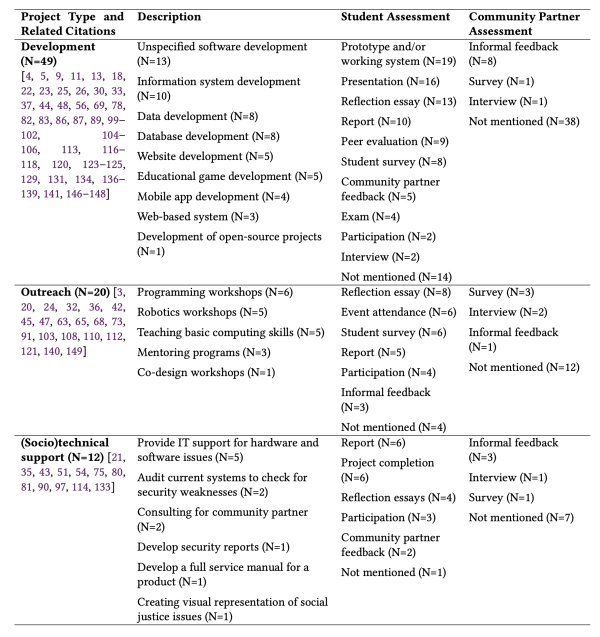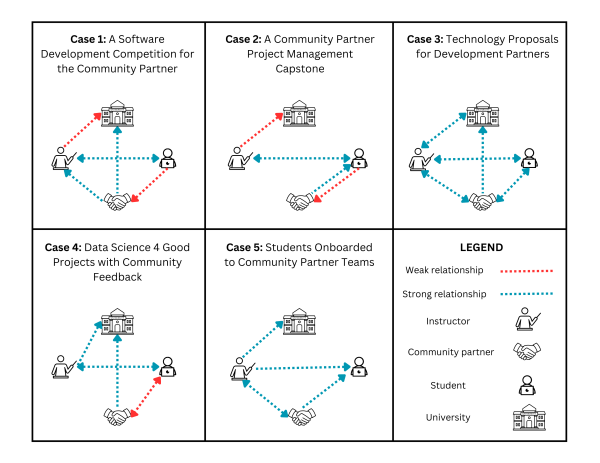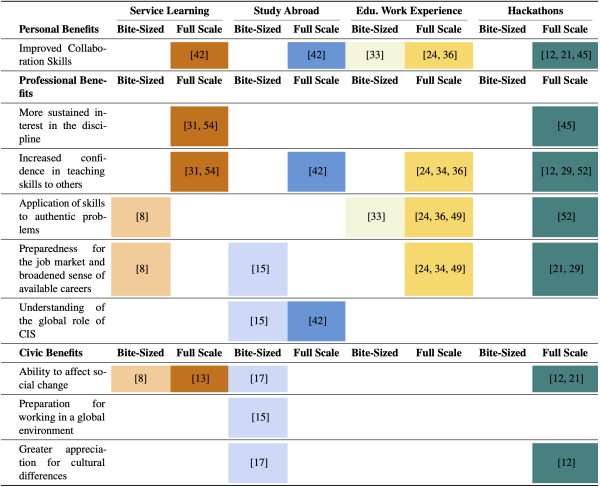This material is based upon work supported by the National Science Foundation under Grant No. 1920851
This research would not have been possible without the contributions of the incredible team of Co-PI Lecia Barker; graduate research assistants Fuji Robledo Yamamoto and Julia Dean; and REU students Vaughn Nagy, Mia Kilkenny, Avery Harrell, and Sidney Lentz.
Service learning is a high-impact pedagogy with numerous potential benefits for students in computer and information science (CIS). However, this pedagogy often requires extra work from faculty and may not consistently benefit community partners, especially in CIS. We conducted six empirical research studies to better understand the current imbalance in benefits across stakeholders while exploring ways to re-balance benefits so that students, faculty, and community partners can all grow personally, professionally, and civically.
- Our literature review of CIS faculty experience reports (Robledo Yamamoto, Barker & Voida, 2023) found that CIS service learning courses have been offered since at least 2000.

- These course experiences highlight a surprising diversity of content areas, project types, and student assessment methods. Most courses were primarily designed for the very beginning or end of the undergraduate curriculum, suggesting a need for more research of service learning at all levels of the undergraduate curriculum. Our comprehensive summary of faculty experience reports can support others in identifying examples of and lessons learned that align with the learning objectives of their own courses.

- We conducted a national survey of students’ experiences with service learning courses (Kilkenny et al., 2022). Students reported that service learning courses supported personal goals (e.g., interest in understanding their communities), professional goals (e.g., applying course concepts to real situations and preparing for careers), and civic goals (e.g., ability to take on community leadership).

- Women students reported greater interest in understanding others and the problems they face in their community than did men. Being required to take a service learning course was associated with more appreciation for professional benefits, suggesting that curricular validation of service learning might be important. Most students who had not taken a service learning course found it appealing.
- The national survey of faculty members’ experience with service learning courses (Harrell et al., 2024) explored the imbalance of service to students and community partners. Faculty reported extensive intended outcomes for students and clearly described how they assessed the outcomes. Yet intended outcomes for community partners were fewer and less explicit; many faculty did not assess whether partners’ outcomes were achieved. Two-thirds of faculty judged student goals as more important than partner goals, and a quarter of respondents considered benefits for partners to be welcome, but unintended. Many faculty stated that their commitment is to teaching, not to community service. Focusing exclusively on students and downplaying partners’ needs may impede development of civic awareness or disposition toward duty among students; it can also result in community organizations avoiding partnerships. Faculty respondents gave advice for elevating the service in service learning, including treating partners as real business clients, preemptively managing expectations, embedding project management, engaging institutional support, and selecting appropriate projects.
- A subset of questions in the faculty survey reported on teaching service learning during the COVID pandemic shutdown (Barker, Voida & Nagy, 2021), yielding advice for education under times of disruption, such as modularizing course content and integrating structured management into projects for ongoing and early accountability.
- We also conducted an interview study of five CIS service learning partnerships (Robledo Yamamoto, Barker & Voida, to appear), interviewing a faculty member, student, and community partner for each of the courses. We found that while success hinges on the development of mutually-reciprocal relationships among stakeholders, there is much variability in how service learning is integrated into CIS courses and in the nature of the relationships that are formed.

- Across this breadth of implementations, we identified three shared strategies for fostering relationship-building in CIS service learning: infrastructuring the relationships, valuing technical and other expertise equitably, and integrating ‘soft‘ skills into the curriculum. Overall, the growth that can emerge from relationship building appears to be an important outcome, both for designing and for assessing the service learning experience. Specifically, we identify how we can design for growth by considering the following: (1) Helping students recognize a more well-rounded slate of growth experiences (e.g., identifying a wide range of professional, civic, and personal goals or learning objectives and as a result, legitimizing these goals for the students); (2) Better supporting community partner and instructor growth, which may vary across stakeholders; and (3) Balancing growth with workload.
- Finally, we conducted an expanded literature review to include additional genres of CIS experiential pedagogies (Dean, Barker & Voida, 2024) beyond service learning, including study abroad, educational work experiences, and hackathons. Across all of these pedagogies, we see an imbalance of benefit between students and faculty, with the added workload to faculty sometimes getting in the way of offering these high-impact experiences for students. Our analysis uncovers ways that faculty have experimented with “bite-sized” experiential pedagogies to make them more accessible for both students and faculty—for example, adding a short study abroad experience over spring break or using a week of class time to host a hackathon.

- We hope these suggestions will inspire faculty to experiment with these pedagogies!